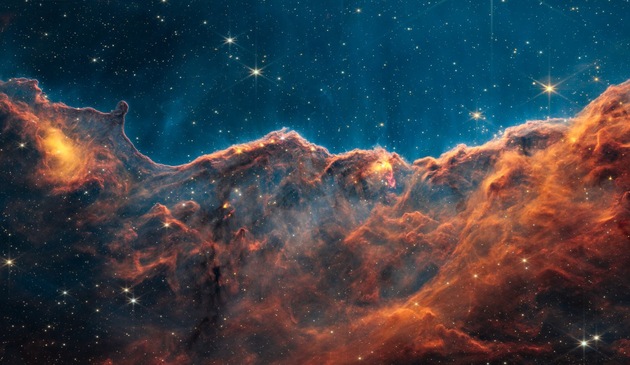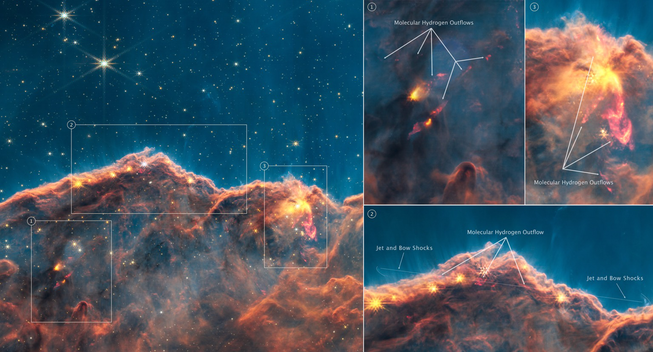Take a 3D Journey Through Webb’s Iconic ‘Cosmic Cliffs’ Photo https://petapixel.com/2025/05/09/take-a-3d-journey-through-webbs-iconic-cosmic-cliffs-photo/ #jameswebbspacetelescope #visualization #carinanebula #cosmiccliffs #astronomy #science #Space #News #jwst #webb #3d
#CosmicCliffs
Stunning new visualization from NASA’s Webb Telescope explores the Cosmic Cliffs, a spectacular ridge of dust clouds, sparkling with a myriad of stars, along the edge of the nebula Gum 31
#CosmicCliffs #Astronomy #Astrophysics #Astrodon #space #science #reserach #STEM #NASA #visualization #Gum31 #news #JWST #Webb #telescope
"Watch as it dives the cosmic riffs to unfold the beauty they behold...~"
What a journey it was to create this piece and I'm so proud and grateful ✨ really hope you enjoy what I created.
#CosmicCliffs #universe #stars #universeunfold #whale #MastoArt #originalart #traditionalmedia
#astronomy #stars #protostars #NGC3324 #CosmicCliffs #JWST
An article published in the journal "Monthly Notices of the Royal Astronomical Society" reports a study of the open cluster NGC 3324, part of the Carina Nebula, one of the largest known star nurseries. A team of researchers used observations conducted with the James Webb Space Telescope to specifically study an area on the edge of NGC 3324 nicknamed the Cosmic Cliffs.
Scientists taking a “deep dive” into one of Webb’s iconic first images have discovered dozens of energetic jets and outflows from young stars previously hidden by dust clouds. Read more at https://go.nasa.gov/3WmXXGQ
#Webb #JWST #CosmicCliffs #Space #Star #Astronomy
(seen at Swiss Space Museum over at FB)
This glittering star-speckled landscape of “mountains” and “valleys” is actually the edge of a nearby region called #NGC3324 in the #CarinaNebula, where young #Stars are forming.
More information about the new discovery: https://www.nasa.gov/feature/goddard/2022/nasa-s-webb-unveils-young-stars-in-early-stages-of-formation/
#SpaceMastodon #Spacedon #Space #Astronomy #Astrodon #ScienceMastodon #Sciencedon #Science #JamesWebbSpaceTelescope #JWST #Webb #CosmicCliffs
The #JamesWebbSpaceTelescope's Near-Infrared Camera (NIRCam) has captured an image of the #CosmicCliffs, revealing dozens of jets and outflows from young #Stars that were previously undiscovered.
More information: https://www.nasa.gov/feature/goddard/2022/nasa-s-webb-unveils-young-stars-in-early-stages-of-formation/
#SpaceMastodon #Spacedon #Space #Astronomy #Astrodon #ScienceMastodon #Sciencedon #Science ##JWST #Webb #NGC3324 #CarinaNebula
We previously saw this view of the #CosmicCliffs through #Webb's first images, but a deeper investigation has revealed young #Stars in a stage of development that was previously unknown to us. This discovery may help us learn more about the formation of stars like the #Sun.
More information: https://www.nasa.gov/feature/goddard/2022/nasa-s-webb-unveils-young-stars-in-early-stages-of-formation/
#SpaceMastodon #Spacedon #Space #Astronomy #Astrodon #ScienceMastodon #Sciencedon #Science #JWST
“It’s like finding buried treasure.”
A deep dive into one of #NASAWebb’s iconic first images—the Cosmic Cliffs—has revealed a treasure trove of extremely young stars in a particularly intriguing stage of formation: https://webbtelescope.pub/3Btx3oE


